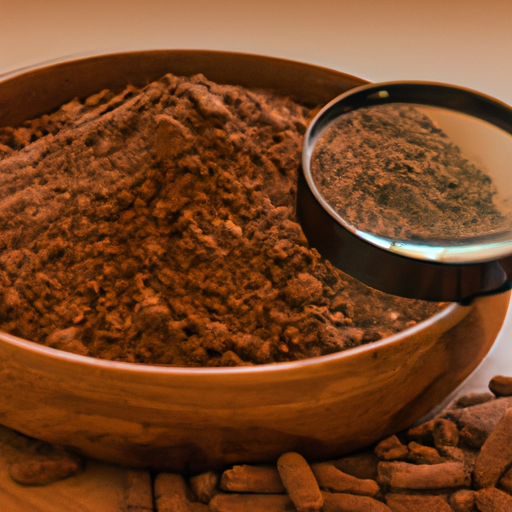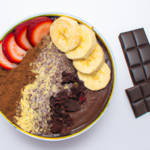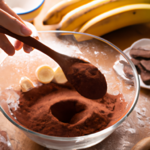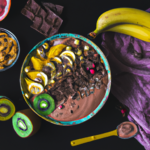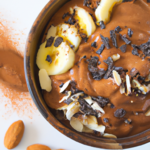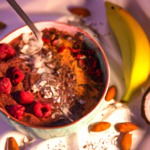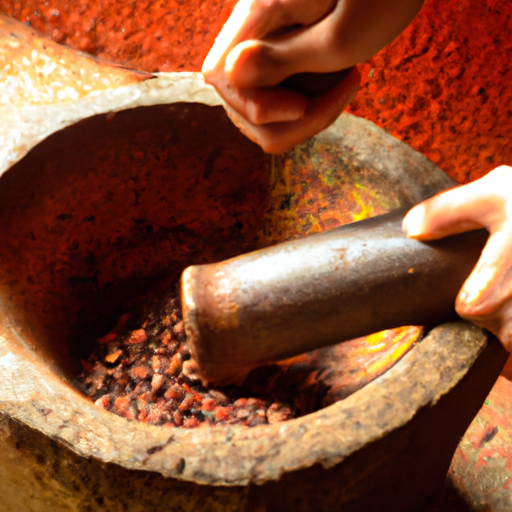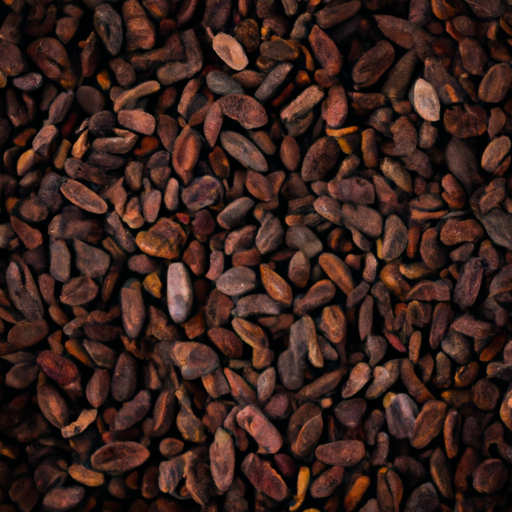Raw cacao offers a range of uses, making it a versatile pantry staple. Check out these ideas for incorporating raw cacao into your daily routine:
-
Start your day off right by adding a spoonful of raw cacao powder to your morning smoothie. Not only will it give your smoothie a rich chocolate flavor, but it will also provide a boost of antioxidants and nutrients.
-
If you’re a coffee lover, try adding a sprinkle of raw cacao powder to your cup of joe. It will give your coffee a delicious mocha twist and can be a healthier alternative to flavored syrups or creamers.
-
Raw cacao can also be used in baking. Swap out regular cocoa powder for raw cacao powder in your favorite chocolate recipes to amp up the flavor and nutritional value. You can use it in cakes, cookies, brownies, and more.
-
Get creative in the kitchen and experiment with savory dishes. Raw cacao can add depth and complexity to sauces, chili, and even marinades for meats. It pairs well with spices like chili powder, cayenne pepper, and cinnamon.
-
For a sweet treat, melt raw cacao nibs or bars and use them as a dip for fruits like strawberries, bananas, or even pretzels. You can also make your own healthier version of chocolate bark by mixing melted raw cacao with nuts, dried fruits, and seeds.
-
Don’t forget about homemade skincare products! Raw cacao butter can be used as a moisturizer for your skin, leaving it soft and supple. You can also make your own chocolate face mask by mixing raw cacao powder with honey and yogurt.
So, whether you’re looking to satisfy your chocolate cravings, boost your morning routine, or get creative in the kitchen, raw cacao has got you covered. Incorporating this superfood into your daily life can not only add a delicious flavor but also provide numerous health benefits. Get ready to indulge in the world of raw cacao and discover all the amazing ways you can enjoy its goodness.
Key Takeaways
- Raw cacao can be used in savory dishes to add a rich and velvety undertone, enhance chili, mole sauce, and marinades, and balance the richness of savory ingredients.
- It is also used in DIY skincare products to rejuvenate and hydrate the skin, make homemade lip balms with raw cacao butter, and nourish and pamper the skin.
- Raw cacao can enhance the flavor of homemade chocolate nut butters and spreads while providing health benefits such as antioxidants, magnesium, and iron.
- It can be enjoyed as a snack on its own, satisfying cravings and offering numerous health benefits. Additionally, raw cacao nibs can be sprinkled on yogurt or oatmeal as a crunchy topping.
Enhance Your Smoothies and Shakes
If you want to take your smoothies and shakes to the next level, adding raw cacao is a game-changer. Using cacao in protein shakes not only adds a rich and indulgent flavor, but it also provides a boost of antioxidants and nutrients.
The natural sweetness of cacao complements the creaminess of the shakes, creating a delightful treat that is both satisfying and nourishing.
Additionally, incorporating cacao into breakfast smoothie bowls adds a decadent twist to your morning routine. The velvety texture and deep chocolate taste elevate the flavors of the fruits and other ingredients, making it a truly indulgent breakfast option.
So, why stop at just smoothies and shakes? Cacao can also be used to create delicious baked goods, adding a depth of flavor and richness that will leave you craving for more.
Create Delicious Baked Goods
Imagine sinking your teeth into a warm, gooey brownie, the chocolatey richness enveloping your tastebuds and bringing you pure bliss.
Raw cacao can be used to create delicious baked goods that will satisfy any chocolate lover’s cravings. By using raw cacao powder in your cake recipes, you can enhance the flavor and create unique combinations that will impress your friends and family.
Additionally, raw cacao nibs can be added to cookies, providing a crunchy texture and intense chocolate flavor.
Whether you’re making a classic chocolate cake or exploring different cookie variations, raw cacao is a versatile ingredient that will take your baked goods to the next level.
And if you’re looking for another way to enjoy the indulgent taste of raw cacao, stay tuned for the next section where we’ll discuss how to make decadent hot chocolate.
Make Decadent Hot Chocolate
Get ready to indulge in a rich and velvety cup of hot chocolate that will warm you up from the inside out. When it comes to making decadent hot chocolate, raw cacao is a game-changer. Not only does it add a deep, chocolatey flavor, but it also provides numerous health benefits. Raw cacao is packed with antioxidants, fiber, and minerals like magnesium and iron, making it a great addition to your diet. By incorporating raw cacao into your hot chocolate, you can explore different variations of recipes, such as adding a hint of cinnamon or a dash of chili powder for a spicy kick. The possibilities are endless! Next, we’ll discover how you can add flavor to your coffee without compromising on taste.
Add Flavor to Your Coffee
To make your coffee more flavorful, try adding a touch of caramel syrup or a sprinkle of cocoa powder.
Flavored coffee is a popular choice among coffee lovers, and it’s easy to see why. By adding a hint of caramel syrup, you can create a rich and sweet taste that complements the bitterness of the coffee.
Alternatively, a sprinkle of cocoa powder can add a subtle chocolatey flavor that pairs well with the boldness of the coffee.
There are countless coffee recipes out there that incorporate different flavors, allowing you to get creative with your morning cup of joe.
Now, let’s move on to the next section and discover how raw cacao can elevate your desserts in surprising ways.
Elevate Your Desserts
When it comes to elevating your desserts, raw cacao can truly take them to the next level.
Whether you’re making homemade ice cream or sorbet, adding raw cacao can bring a rich and intense chocolate flavor.
Puddings and mousses also benefit from the addition of raw cacao, creating a velvety and decadent texture.
And for those looking to indulge in some luxurious treats, truffles and chocolate bark made with raw cacao are the perfect indulgence, with their creamy centers and irresistible crunch.
Ice cream and sorbet
Indulge in the velvety richness of homemade ice cream and sorbet, using raw cacao to infuse your frozen treats with a decadent chocolate flavor. Not only does raw cacao add depth to your desserts, but it also offers numerous health benefits.
Here are three ways you can elevate your ice cream and sorbet with raw cacao:
-
Dairy-free alternatives: Substitute traditional milk or cream with plant-based options like coconut milk or almond milk to create a creamy and luscious base for your frozen treats.
-
Unique flavor combinations: Experiment with different ingredients such as mint, raspberry, or peanut butter to create exciting flavor profiles that pair perfectly with the intense chocolate notes of raw cacao.
-
Boost of antioxidants: Raw cacao is packed with antioxidants that promote heart health and improve mood. By incorporating it into your ice cream and sorbet, you not only satisfy your sweet tooth but also nourish your body.
Now, let’s move on to the next section about puddings and mousses, where raw cacao continues to shine.
Puddings and mousses
Get ready to dive into the world of rich and creamy puddings and mousses. The velvety texture of homemade desserts will leave you wanting more. Raw cacao adds a delightful twist to these sweet treats while also providing numerous health benefits.
Packed with antioxidants, minerals, and fiber, raw cacao can help improve cardiovascular health, boost mood, and enhance cognitive function. Incorporating raw cacao into puddings and mousses not only satisfies your sweet tooth but also nourishes your body.
When it comes to creative recipes, the possibilities are endless. You can whip up a decadent chocolate avocado mousse, a silky chocolate chia pudding, or a luscious chocolate banana pudding. The rich flavor of raw cacao pairs perfectly with fruits, nuts, and spices, allowing you to experiment and create unique and delicious desserts.
Now, let’s transition into the next section about truffles and chocolate bark, where raw cacao takes center stage once again.
Truffles and chocolate bark
Immerse yourself in the world of truffles and chocolate bark, where you’ll discover a luxurious assortment of handcrafted confections to delight your taste buds.
When it comes to truffles, the possibilities are endless. From classic dark chocolate truffles to unique flavors like raspberry or mint, there are countless truffle recipes to explore. Get creative with different coatings like cocoa powder, crushed nuts, or even edible gold dust.
As for chocolate bark, it’s a simple yet impressive treat that can be customized to suit any occasion. Mix in your favorite nuts, dried fruits, or even spices like chili powder for a unique twist. The rich, velvety texture of raw cacao lends itself perfectly to these decadent treats.
Now, let’s dive into how you can also use it in savory dishes.
Use it in Savory Dishes
Incorporating raw cacao into savory dishes adds a touch of decadence, infusing them with a rich and velvety undertone. While raw cacao is commonly associated with sweet treats, it can also be used in surprising and delicious ways in savory recipes.
Its deep chocolate flavor enhances dishes like chili, mole sauce, and even marinades for meats. The bitterness of raw cacao helps balance out the richness of savory ingredients, creating a harmonious and complex flavor profile.
Additionally, raw cacao is packed with antioxidants and minerals, providing potential health benefits when incorporated into savory dishes. So why limit raw cacao to just desserts when it can bring a whole new level of indulgence to your savory creations?
Now, let’s explore another exciting use for raw cacao: creating DIY skincare products.
Create DIY Skincare Products
Discover the magic of creating your own luxurious skincare products using raw cacao.
This versatile ingredient will leave your skin feeling nourished and pampered.
DIY face masks are a popular choice, as raw cacao is rich in antioxidants that can help rejuvenate and hydrate the skin.
Simply mix raw cacao powder with ingredients like honey, avocado, or yogurt for a spa-like experience at home.
You can also make homemade lip balms by combining raw cacao butter with essential oils and beeswax.
These lip balms will not only moisturize your lips but also provide a subtle chocolatey aroma.
In the next section, we will explore how to mix raw cacao into nut butters and spreads, adding a touch of indulgence to your everyday snacks.
Mix it into Nut Butters and Spreads
Enhance your nut butters and spreads with the irresistible flavor of homemade chocolate, taking your snacking experience to a whole new level of indulgence. Adding raw cacao to your nut butter recipes not only satisfies your sweet tooth but also provides numerous health benefits.
Raw cacao is packed with antioxidants, which help protect your cells from damage caused by free radicals. It also contains minerals like magnesium and iron, which are essential for overall well-being. By incorporating raw cacao into your spreads, you can enjoy the rich taste of chocolate while reaping the nutritional rewards.
But don’t limit yourself there! Raw cacao is so versatile that you can also enjoy it as a snack on its own or experiment with other delicious recipes.
Enjoy it as a Snack on its Own
Satisfy your cravings and indulge yourself with the rich, velvety taste of homemade chocolate as a snack on its own.
Raw cacao is not only delicious, but it also offers numerous health benefits.
There are several ways to incorporate raw cacao into your daily routine as a snack.
One simple option is to sprinkle raw cacao nibs on top of yogurt or oatmeal for a crunchy and chocolatey twist.
Another unique recipe using raw cacao as a snack is to make energy balls by blending dates, nuts, and raw cacao powder. These bite-sized treats are packed with nutrients and provide a natural energy boost.
Additionally, you can make a homemade hot chocolate by mixing raw cacao powder with hot milk and a touch of sweetener.
So go ahead and enjoy raw cacao as a snack, guilt-free!
Frequently Asked Questions
Is raw cacao safe to consume for people with chocolate allergies?
Raw cacao can be a delightful treat, but for those with chocolate allergies, caution is necessary. Allergies to raw cacao can cause symptoms like rashes or difficulty breathing. However, non-allergic individuals can enjoy the numerous benefits of raw cacao, such as its antioxidant properties and mood-enhancing effects.
Can raw cacao be used as a substitute for cocoa powder in recipes?
Yes, raw cacao can be used as a substitute for cocoa powder in recipes. It has a stronger, more intense flavor and contains more nutrients than cocoa powder, making it a beneficial addition to dessert recipes.
How does raw cacao differ in taste from regular chocolate?
Raw cacao has a more intense and bitter taste compared to regular chocolate. It also retains more nutrients and antioxidants due to minimal processing, offering health benefits like improved heart health and mood enhancement.
What is the recommended daily serving size of raw cacao for optimal health benefits?
The recommended serving size of raw cacao for optimal health benefits is approximately 1 to 2 tablespoons per day. Consuming this amount can provide a range of health benefits due to its rich antioxidant content.
Can raw cacao be used as a natural remedy for certain health conditions?
Raw cacao can be beneficial for heart health due to its high levels of antioxidants and flavanols. It may also support digestive health by promoting gut flora balance and reducing inflammation in the digestive system.
– What are the Uses of Raw Cacao?
There are numerous cacao raw benefits explained. Raw cacao can be used to make chocolate, smoothies, and desserts. It is also packed with antioxidants, iron, magnesium, and other essential nutrients. Consuming raw cacao may support heart health, enhance mood, and boost energy levels.
Conclusion
In conclusion, incorporating raw cacao into your daily routine can bring a touch of indulgence and flavor to various aspects of your life.
Some of the ways you can use raw cacao include enhancing your morning smoothie, baking delectable treats, and creating a luxurious cup of hot chocolate.
By adding raw cacao to your smoothie, you can elevate its taste and make it even more enjoyable.
When it comes to baking, raw cacao can be used in a wide range of recipes, from cookies and brownies to cakes and muffins.
And of course, there’s nothing quite like a warm cup of hot chocolate made with raw cacao. It’s a comforting and decadent treat that can be enjoyed on its own or topped with whipped cream and sprinkles.
With its rich antioxidant content and numerous health benefits, raw cacao is not only a delicious addition but also a nutritious one.
So go ahead, embrace the velvety goodness of raw cacao and let your taste buds dance with delight.


